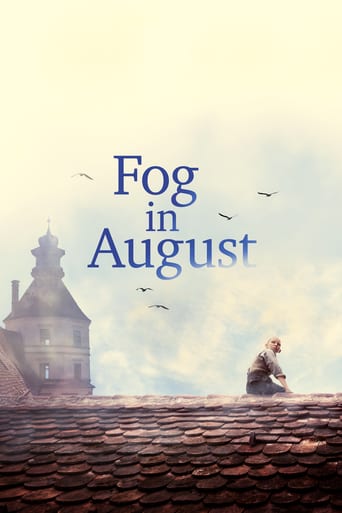

Good story, Not enough for a whole film
... View MoreIn truth, there is barely enough story here to make a film.
... View MoreStory: It's very simple but honestly that is fine.
... View MoreThe movie really just wants to entertain people.
... View MoreFinding this movie was a big surprise. The title and subject were a drawcard but, did not expect to find a modern German treatment of this theme, to be so near perfection. It's un-sensationalistic and visually striking - with both the director Kai Wessel and cinematographer Hagen Bogdanski pulling out all stops to create a fully involving experience. Based on actual events as documented in Robert Dome's novel (Domes won both the Gustav Heinemann Peace Prize and the Lufti literature prize for this work). The screenplay adaptation by prolific writer/actor Holger Karsten Schmidt, might perhaps feature some over extended elements (in a couple of minor details) - for some, this may also include the unnecessary addition of a 'symbolic' character - in an attempt to add an uplifting finale (although the movie is honest enough to fully acknowledge this!).Impressive performances litter this thoughtful production - featuring standout leads from Ivo Pietzcker as Ernst Lossa, the young Yenish lad sent to a Nazi sanatorium while waiting for his father to be processed in a camp, Sebastian Koch as the enigmatic Dr Veithausen (a character not easily forgotten) Henriette Confurius and Fritzi Haberlandt as nurses with conflicting views on the Fuhrer's methods. Many other vibrant cast members shine throughout. There's even a look at the acquiescence of the Catholic Church during this shocking time. The situations depicted creep up on you until the full extent of their seriousness is realised. While this theme (factual) may not appeal to everyone (but what does?) those who like movies based on contemporary historical events - brought to life in compelling detail, should not be disappointed. Highly recommended for serious viewers.
... View More... given that German films on the subject usually let you feel somewhat detached. Whenever the Holocaust is concerned, German filmmakers tend to try to do everything according to the book, as meticulously factual as possible, so viewers can easily feel lectured.There is a good deal of that strife for perfection in here as well, as a whole lot of neglected issues are crammed into this one film: the Nazi euthanasia program involving feeding patients nutrition-less food called "Ersatzkost", substitute nourishment. The silent acquiescence of the Catholic church to mass murder carried out in institutions under their formal patronage. The lumping together of all kinds of "undesirables" labeled mentally unfit to live. And in the guise of the lead, the still unfilmed "Porrajmos" (which means "devouring"), the destruction of much of Europe's Romani population no one cares about until today.It's all a bit much and doesn't help the narrative structure, but there is a lot to learn, even for those who've seen a good deal of films about the subject. Apart from "Schindler's List", hardly any film explains the ideology and motivation behind these crimes. The extremely fascinating - while sickening - quality of this film is that it shows doctors and nurses murdering children without any malice, all in the name of the "greater cause" of racial purity. As incredibly inhumane this seems to the viewer - and the sole heroine of the story, a catholic nun - the sources from that time indicate that this was indeed how the culprits thought. Sebastian Koch, whom I usually find rather wooden, brings this uncanny mix of "scientific" curiosity and complete lack of conscience perfectly across. It's his best film, better than "The Lives of Others".What this film is not is the heavily overdue film about the persecution of gypsies. It's misleading to call the protagonist Ernst Lossa a Rom, he was a Jenische, they are non-ethnic travellers like in Ireland and don't speak Romanes. They mostly reside in Switzerland, where Jenische children were taken away from their families to "socialize" them until 1968... as you see, there remain many, many more stories to tell.
... View MoreI don't actually know why the movie is called "Fog in August" as that image is never referenced in the movie. It is taken from the eponymous book it's based on, perhaps it is explained there.The historical backdrop of the movie is "T4", the Nazi campaign to kill those deemed "unworthy to live" because they were handicapped, suffered from a psychiatric condition or -- in many cases -- were just unruly or even merely unpopular with the authorities. The film acts as a docudrama, trying to get some historical facts across while narrating the coming of age-story of Ernst Lossa, a around fourteen-years-old rapscallion. In real life, his father was eventually murdered by the Nazis because he was a traveling artisan.The film creates some dramatic tension by pitching two nurses against each other in an unlikely fashion. Stern-looking "mother superior" Sophia is a devout catholic who does the right thing by trying to protect her wards, while doe-eyed sister Edith acts as the angel of death, killing children on command by giving them raspberry juice mixed with barbiturates.There is nothing wrong with this movie, and it has a great cast to boot. On the other hand, it's simply another moral showcase about Nazi evils, and you have to be somewhat masochistically inclined to watch it voluntarily. I'm worried that a large part of German cinematic production these days is uninspired "propaganda for the right cause". Hopefully, this movie will inspire many viewers to research the history of T4 on their own.
... View More